The impact and effect of new board leadership on a nonprofit organization (NPO) is often immediate. It can have a significant influence and typically sets the bar and pace for other board members to emulate in terms of commitment, gift size, and degree of engagement. Other organizational leaders, including board committee chairs, campaign chair people, executive leadership and advancement leadership, are also important but do not have same potential for lighting a fire under board members as does the board chairperson.
As a result, it is critical that great care and consideration are taken with your organization’s leadership continuity planning. This includes choosing a board chair as well as constructing a succession and nominating strategy through your nominating or governance committee. When considering new leadership, there are many important variables to consider and prioritize. These may include the nominee’s professional expertise, communication skills, financial resources, rolodex, time availability and, yes, leadership qualities. However, here is something to consider: I would argue that the most important characteristics for success would have to be the nominee’s enthusiasm and dedication to the mission of the NPO.
Consider this true story. One of Copley Raff’s former clients is a prominent cultural organization with both earned revenue and community benefit programming. A relatively new trustee quickly ascended to the chair of the board as a result of the urging of the organization’s executive director. This new chair had special skills in negotiating big deals and also happened to be quite wealthy. Professionally, she was at the top of the financial services food chain.
The executive director’s strategy was successful and the new chair was helpful in landing a significant business relationship for the NPO. At the same time, Copley Raff was preparing for the launch of the organization’s largest campaign to date. Through the course of our interviews, it became clear that key constituents were awaiting news on the chair’s gift to the campaign to help set the bar and truly ignite the effort. Clearly, her gift would set the pace for the others and carried tremendous importance.
And the results? Disappointing at best. Although she had capacity, organizational authority, and a challenge from another board member offering to match her gift up to $5 million, the chair committed to only $500,000 – 10% of what was hoped for. She explained that she and her family were “tapped out” from other recent gifts that would result in the naming of buildings on the campuses of two prominent universities.
So how did this all play out? Because of the significantly less than expected chair gift and challenge match totals, the overall goal of the campaign had to be lowered. As a result, the scope of services offered to the community – as defined by the NPO’s mission and funded by philanthropy – were greatly reduced. While these are hard pills to swallow, the board and executive director now have a much greater appreciation for the importance of succession planning and leadership vetting.
Every player in this scenario holds some responsibility for the less than optimum outcome of this campaign launch.
Mistake #2: The chair made a conscience decision that essentially assigned a value to the mission of her two alma maters and the cultural organization, which were publicly reflected in her giving. As a result of her lack of enthusiasm for the cause, the entire success of the organization’s fundraising suffered.
Mistake #3: Did the chairperson need to be elevated to that position in order to capture her help and expertise in making the needed deals? Probably not. In retrospect, this seems very short sighted and a misalignment of skills, needs, and timing.
Mistake #4: It is clear that the governance committee failed to examine the chair’s enthusiasm and dedication to the NPO’s mission and was not properly vetted. By missing these two considerations the campaign clearly suffered as a result.
Your takes:
- Do not assign gift expectations based solely on the donor’s wealth and relationship to the organization.
- Executive directors need to have strong rapport with board leaders so a comprehensive, trusting, and authentic relationship can be attained.
- Be aware that wealthy donors often have many causes and as a result, timing plays a big role in philanthropy outcomes. Ask open ended questions to gauge competing interests, campaigns, and priorities.
Have a development, executive recruitment, or campaign strategy or management challenge? Let’s talk! Click here to connect with Rebekah Kaufman, Director of Consulting Services at CRI.


